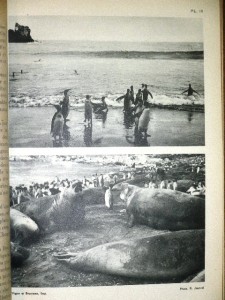
- This event has passed.
This day in history: a scientist goes ashore on Marion Island from the French Navy sloop Bougainville in 1939
January 23, 2016 @ 8:00 am - 5:00 pm

Under the command of Capitaine de Vaisseau Fabre de la Ripelle, the French aviso (colonial sloop) F.R. Bougainville sailed from Diego-Suarez, Madagascar on 11 January 1939 via Durban, South Africa for the French sub-Antarctic in the southern Indian Ocean on a scientific cruise and to affirm French sovereignty over its islands.

On her way south the ship called at Marion Island, arriving at dawn on 23 January 1939 where she remained until the early morning of 24 January, when she departed for the Iles Crozets, Ile Kerguelen and Iles Amsterdam and St Paul. The cruise ended in Reunion on 3 March 1939. Intriguingly, before the voyage a preparatory conference held in December 1938 considered who owned the Prince Edward Islands, concluding the British claim was not certain and therefore a landing should be attempted, but on (in translation) “the express condition not to leave any trace of its visit”.


The Bougainville anchored 750 m off Ship’s Cove and after an initial inspection sent a party ashore in a whaler, towed by a motor boat, in the midmorning. The motor boat then undertook a hydrographic survey. On the way the 1908 wreck of the Norwegian sealer Solglimt in the cove was observed, as were the remains of a wrecked motorboat, thought from the same incident, on the black sand beach. The shore party then made a wet landing from a flooded boat in rough surf in the cove before exploring inland, reporting on what remained of the Solglimt shipwreck village where 79 sealers spent a month ashore before being rescued. Dr René Jeannel, a Professor at the Muséum National d’Histoire Naturelle in Paris entered a half-demolished hut behind the beach that contained (in translation) “a rickety table with s few rusty utensils”. Jeannel climbed above Ship’s Cove, reaching an altitude of 200 m. With the help of three sailors he collected invertebrates and made notes on the vegetation, seabirds and marine mammals while three officers from the ship made geodesic, magnetic and topographic observations.


![]()
![]() The ship’s siren called the shore party back after some hours, but a second landing by ship’s officers was made at nightfall to observe the stars and calculate a position, hampered by cloudy weather and cut short by a drop in barometric pressure. Jeannel wrote that the landing cove is to be named after him as the “Baie de Jeannel”, or “Crique Jeannel” according to the Captain, but neither appellation has survived.
The ship’s siren called the shore party back after some hours, but a second landing by ship’s officers was made at nightfall to observe the stars and calculate a position, hampered by cloudy weather and cut short by a drop in barometric pressure. Jeannel wrote that the landing cove is to be named after him as the “Baie de Jeannel”, or “Crique Jeannel” according to the Captain, but neither appellation has survived.
The 1970-tonne Bougainville was launched in 1932 after which it was commissioned into the French Navy. This class of ship was designed to operate from French colonies in Asia and Africa, with a shallow draft that allowed approaches to small harbours and entries into river mouths. In June 1940 she was transferred to the Vichy French Navy. In the Battle of Gabon, West Africa on 9 November 1940 she was sunk by her sister ship, the Savorgnan de Brazza of the Free French Navy. Zut alors!
Acknowledgements:
With grateful thanks to Maëlle Connan and Sylvia Vandenabeele for translating the French texts into English, Bob Headland for copying photographs in Jeannel (1941), Jay Gates for researching information on and photographs of the Bougainville and Nico de Bruyn for help identifying geographical features photographed by the expedition.
References:
de la Ripelle. M.H.F. 1947. Croisière du “Bougainville” dans l’Océan Indien Austral. (11 Janvier – 3 Mars 1939). Annales Hydrographiques 3rd Series 19: 121-177.
Jeannel, R. 1940. Croisière du Bougainville aux Iles Australes Françaises. I Partie générale. Mémoires du Muséum National d’Histoire Naturelle. 14: 1-46.
Jeannel, R. 1941. Au Seuil de l’Antarctique. Croisiere du “Bougainville” aux des Manchots ete des Éléphants de Mer. Paris: Publications du Muséum National d’Histoire Naturelle. No. 5. 236 pp.
John Cooper, Principal Investigator, Antarctic Legacy of South Africa, Department of Botany and Zoology, Stellenbosch University
